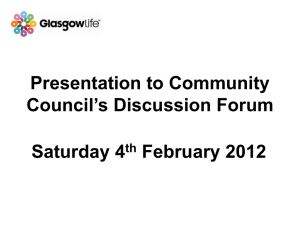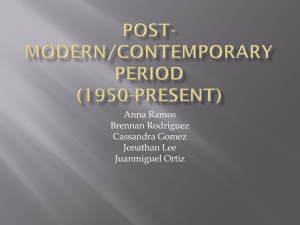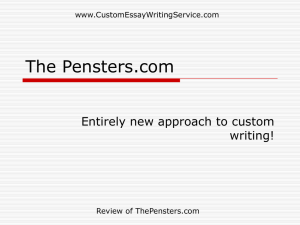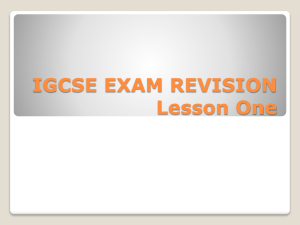Close Reading using 2010
advertisement
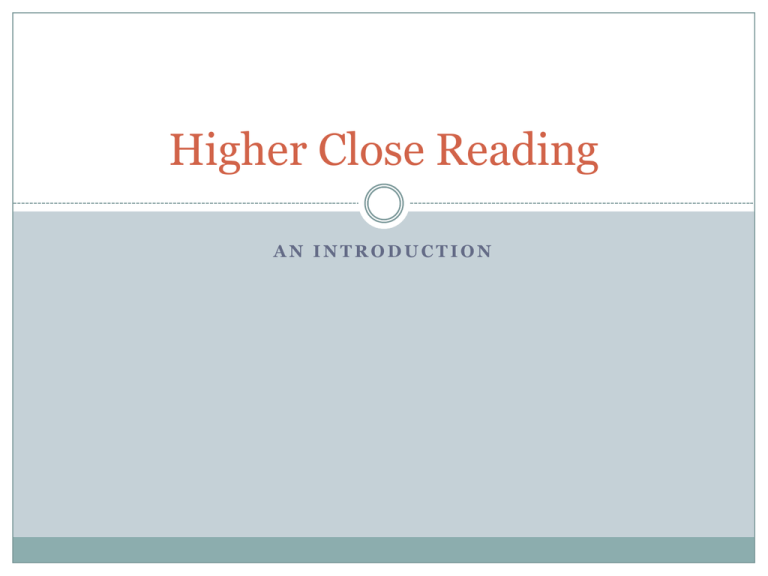
Higher Close Reading AN INTRODUCTION What Is Close Reading Forty per cent of overall award Two non-fiction passages on a common subject Fifty marks worth of questions testing Understanding, Analysis and Evaluation. 1 hr 45 minutes to complete Question Types Understanding- what points are being made by the writer? You must use your own words when answering these question. Analysis- what techniques are being used by the writer? You must identify the correct techniques, give examples and explain/ analyse them. Evaluation- how effective is the writer in what they are attempting? 1 (a) Explain which groups of people are being attracted to cities. Answer briefly, do not repeat the question, in your own words. The question is worth two marks. Therefore, your answer must contain two different groups of people. In a world changing faster now than ever before, the dispossessed and the ambitious are flooding into cities swollen out of all recognition. Those who have lost their own homes Those who are seeking to improve their lives Word Choice The first step is to pick out /identify the most important words. 2. Quote the words in your answer 3. Comment on the word or phrase’s connotations (what do you associate with it). Do not simply comment on its meaning 4. Explain how this helps you to understand the writer’s ideas/opinion. 1. Comment on the writer’s word choice in the following sentence. “Oil prices have rocketed in recent years.” The word choice of ‘rocketed’ suggests that prices have risen in a sudden and dramatic manner. In a world changing faster now than ever before, the dispossessed and the ambitious are flooding into cities swollen out of all recognition. Poor cities are struggling to cope. Rich cities are reconfiguring themselves at breakneck speed. China has created an industrial powerhouse from what were fishing villages in the 1970s. Lagos and Dhaka attract a thousand new arrivals every day. In Britain, central London’s population has started to grow again after 50 years of decline. ‘Swollen’ suggests harmful, painful growth ‘Flooding’ has connotations of something overwhelming, suggesting that cities are struggling to cope. Referring to lines 7–14, explain two ways in which “That version of London would seem like a village now” (lines 10–11). Find the quotation. Look for the answers nearby. Answer in your own words We have more big cities now than at any time in our history. In 1900, only sixteen had a population of one million; now it’s more than 400. Not only are there more of them, they are larger than ever. In 1851, London had two million people. It was the largest city in the world by a long way, twice the size of Paris, its nearest rival. That version of London would seem like a village now. By the official definition, London has getting on for eight million people, but in practical terms, it’s a city of 18 million, straggling most of the way from Ipswich to Bournemouth in an unforgiving rash of business parks and designer outlets, gated housing and logistics depots. Population has greatly increased. The size and reach of the city has also increased massively. Now contains a much greater variety of outlets. Show how the writer’s use of language in lines 15–20 conveys the Victorians’ disgust at the city they had created. You should refer in your answer to such features as imagery, word choice, sentence structure . . . (4A) Four marks- at least two examples. Two marks for each fully explained example. Imagery Questions Identify and quote the image (this will be an example of simile, metaphor or personification) 2. Explain its literal origin. 3. Explain clearly what it is being compared to. 4. Explain why this comparison is effective in conveying the writer’s point (make sure you say what their point is). 1. Show how the writer’s use of imagery helps to convey his argument. (2A) Too many tourists are so wedded to their camera that they cease to respond directly to the places of beauty they visit. They are content to take home a dozen rolls of exposed film instead, like a bank full of monopoly money. The simile ‘like a bank full of monopoly money’ conveys the writer’s feelings that tourists do not properly experience the destinations they visit. He does so by comparing the fake and worthless money of a board game to their rolls of photographs from holiday. This suggests that, just as monopoly money is an inauthentic substitute, with little value, so photographs are no substitute for memories based on true interaction. Having invented the modern city, 19th century Britain promptly reeled back in horror at what it had done. To the Victorians exploring the cholera-ridden back alleys of London’s East End, the city was a hideous tumour sucking the life out of the countryside and creating in its place a vast polluted landscape of squalor, disease and crime. In their eyes, the city was a place to be feared, controlled and, if possible, eliminated. Metaphor of ‘tumour’ -a poisonous growth, which spreads- is compared to the growth of the city, suggesting they saw its spread as dangerous. Sentence structure- list at end of paragraph. This uses a tri-colon to list the negative ways in which they viewed the city and wanted to behave towards it. This climaxes with ‘to be destroyed’, a particularly extreme desire, effectively highlighting the extreme disgust they felt towards the city. In lines 21–25, the writer tells us that for the first time in history more people are now living in cities than in the countryside. Show how the writer’s use of language in this paragraph emphasises the momentous nature of this change. Use of language= word choice, imagery, sentence structure, tone Such attitudes continue to shape thinking about the city. Yet, like it or not, at some point in 2008, the city finally swallowed the world. The number of people living in cities overtook those left behind in the fields. It’s a statistic that seems to suggest some sort of fundamental species change, like the moment when mankind stopped being hunter gatherers and took up agriculture. Word choice of ‘fundamental species changes’ suggests that it is a development that almost redefines who we are as people. Read lines 26–31. Explain in detail why the writer thinks the city is “mankind’s greatest single invention” (line 31). The future of the city has suddenly become the only subject in town. It ranges from tough topics such as managing water resources, economic policy, transport planning, racial tolerance and law enforcement to what is usually presented as the fluffier end of the scale, such as making public spaces people want to spend time in and deciding the colour of the buses. But it is this diversity which powerfully affirms the city as mankind’s greatest single invention. Life within the city encompasses an extremely wide- range and contrasting set of issues. It connects many seemingly different aspects of life. Read lines 32–37. Give any two reasons why cities “must be counted as a positive force”. For all their agonies, cities must be counted as a positive force. They are an engine of growth, a machine for putting the rural poor onto the first rung of urban prosperity and freedom. Look at London, a city that existed for several centuries before anything approximating England had been thought of. It has a far stronger sense of itself and its identity than Britain as a whole or England. It has grown, layer on layer, for 2000 years, sustaining generation after generation of newcomers. Cities encourage expansion and progression of societies. They also encourage social and economic mobility. It creates stronger local identities Their growth allows them to provide for vast amounts of people. Read lines 38–46. (a) Explain how any one of the examples in these lines illustrates the surprising nature of the way London has changed over time. (b) Show how the sentence structure of the paragraph as a whole emphasises the idea of change. You see their traces in the Spitalfields district, where a French Huguenot chapel became, successively, a synagogue and a mosque, tracking the movement of waves of migrants from poverty to suburban comfort. London’s a place without an apparent structure that has proved extraordinarily successful at growing and changing. Its old residential core, sheltering in the approaches to its Tower of London fortress, has made the transition into the world’s busiest banking centre. Its market halls and power stations have become art galleries and piazzas. Its simple terraced streets, built for the clerks of the Great Western Railway in Southall, have become home to the largest Sikh community outside India. Same building has been a centre of worship for different religious groups. This highlights the different migrant groups who have came to London, often under difficult circumstances and integrated into the city Sentence Structure Questions Show how the writer uses sentence structure to . . . How effective do you find the writer’s use of sentence structure . . . Comment on the writer’s use of language. Refer to the writer’s style. Comment on the effect of 1. 2. 3. 4. 5. Length- particularly long or short? If so, why? Use of punctuation for effect. Explain what the effect is. Repetition. Word order / inversion. Use of climax or anticlimax. Punctuation Identify features of punctuation and explain their effect. You will receive no marks for identification alone. The Scottish race has been variously and plentifully accused of being dour, mean, venal, sly, narrow, slothful, sluttish, nasty, dirty, immoderately drunken, embarrassingly sentimental, masterfully hypocritical, and a blueprint for disaster when on the football field. Comment on the structure and effect of this sentence. No marks Commas are used to create a list structure Commenting on Effect The sentence consists of a long list of the faults of the Scots. It makes their faults seem endless, as if there were no hope of redeeming features. Length Writers use short sentences to . . . Writers use long sentences to . . . Length Writers use short sentences to . . . Create emphasis, indicate a dramatic shift in their argument, suggest brevity. Writers use long sentences to . . . Indicate there is a vast amount of something, suggest the passing of a long period of time Identify the following punctuation marks and give a reason for using each one : 2. ; 3. 1. - Identify the following punctuation marks and give a reason for using each one : Colon. This is used to introduce something, often an explanation or an expansion of a point. 2. ; Semi-colon. This is either used to separate clauses in a complicated list, or to join related statements. 3. - Dashes are used to create parenthesis. This helps to separate additional information. Commas and brackets can also be used for this purpose. 1. Dismissing a complaint about sexism with the phrase "do me a favour, love" certainly has the structure of a joke, albeit a crap one. But whether he meant it or not, my point is this: without the accompanying facial expressions, we are missing 50% of the context. And context is vital. In the context of a live club appearance, a standup will say things that would be a sackable offence if repeated in the workplace, or lead to death threats if hysterically recounted on the front page of a national paper accompanied by a portrait snap. The repetition of ‘context’ three times highlights that where and when jokes take place is fundamental in making them acceptable or unacceptable. Use of a colon introduces and highlights the importance of his point that we can not judge whether the comment was ironic because it has been stripped of its context. This is reinforced by the following short sentence. You see their traces in the Spitalfields district, where a French Huguenot chapel became, successively, a synagogue and a mosque, tracking the movement of waves of migrants from poverty to suburban comfort. London’s a place without an apparent structure that has proved extraordinarily successful at growing and changing. Its old residential core, sheltering in the approaches to its Tower of London fortress, has made the transition into the world’s busiest banking centre. Its market halls and power stations have become art galleries and piazzas. Its simple terraced streets, built for the clerks of the Great Western Railway in Southall, have become home to the largest Sikh community outside India. Three final sentences follow a similar pattern. Repetition of ‘its’ –a reference to London- draws attention to their similarity. All start by mentioning an old feature of London and end by mentioning what it has changed into in the modern day city. Therefore, the structure of the sentences mirrors the process of change. Their similarity emphasises how widespread such change has been in London. Show how the image of the “à la carte menu” illustrates the point the writer is making in lines 47– 51. Imagery- explain what the literal origin is. State what it is being compared to. Explain how this comparison relates to the writer’s point. (Remember to say what this point is) An ‘a la carte menu’ is one which allows a diner to choose between a wide range of food. This is being compared to life in a city. This helps the writer to illustrate the wide range of lifestyle choices; the great amounts of diversity, that cities encourage. Read lines 52–65. (a) According to the writer, what is the key difference between successful cities and unsuccessful cities? (b) Show how the writer’s use of language in these lines emphasises this difference. Successful cities encourage progression and transformation; unsuccessful ones remain static. The cities that work best are those that keep their options open, that allow the possibility of change. The ones that are stuck, overwhelmed by rigid, stateowned social housing, or by economic systems that offer the poor no way out of the slums, are in trouble. A successful city is one that makes room for surprises. A city that has been trapped by too much gentrification or too many shopping malls will have trouble generating the spark that is essential to making a city that works. Successful cities are the ones that allow people to be what they want; unsuccessful ones try to force them to be what others want them to be. A city of freeways like Houston or Los Angeles forces people to be car drivers or else traps them in poverty. A successful city has a public transport system that is easy to use; an unsuccessful city tries to ban cars. Sentence structure. Two balanced sentences which use semi-colons. In each sentence, the first clause illustrates the options and possibilities that a successful city offers to its citizens; the second clause highlights the restrictive nature of unsuccessful cities. This helps to emphasise this contrast between the different notions of cities. Read lines 1–8. (a) Explain why, according to the writer, Glasgow was in the past an important world city. (b) Explain why Glasgow could be considered important now. (c) Show how the writer’s use of language in lines 3–8 (“This is a city . . . The moon.”) emphasises Glasgow’s importance. Glasgow is a city which has experienced constant change and adaptation, from its period as a great industrial city and as the Second City of Empire, to its latter day reinvention as the City of Culture and the Second City of Shopping. This is a city with pull, buzz, excitement, and a sense of style and its own importance. It has a potent international reach and influence. Glasgow’s story continually weaves in and out of a global urban tapestry: following the trade threads of Empire, there are nearly two dozen towns and cities around the world named after Glasgow—from Jamaica to Montana to Nova Scotia. And there is even a Glasgow on the moon. It used to be extremely important for manufacturing/ had an integral role in Britain’s imperial actions Is now extremely important for retail and entertainment Sentence structure- colon used to introduce a list of the many places internationally that Glasgow has influenced. The use of the list, which is extended through the use of parenthesis, makes it seem like Glasgow’s influence is ubiquitous. This is reinforced by the final short sentence. Read lines 9–16. (a) What does the writer mean by the words “radical” (line 13) and “derivative” (line 14) in his discussion of city development? (b) Show how the writer’s use of language in lines 9– 16 suggests his doubts about the alleged “success story” of Glasgow. Glasgow’s constant proclamation of its present success story is justified on the basis that it benefits the city: confidence will breed confidence, tourists will visit, businesses will relocate and students will enrol. But, despite the gains this approach has brought for Glasgow and cities like it, there are signs that the wind is starting to come out of the sails. What felt radical when Dublin, Barcelona and Glasgow embarked on the city makeover path in the late 1980s and early 1990s, now feels derivative and is delivering diminishing returns. When every city has commissioned a celebrity architect and pedestrianised a cultural quarter, distinctiveness is reduced to a formula. Radical- original approach to city planning and promotion Derivative- copying the ways other cities have been reinvented Glasgow’s constant proclamation of its present success story is justified on the basis that it benefits the city: confidence will breed confidence, tourists will visit, businesses will relocate and students will enrol. But, despite the gains this approach has brought for Glasgow and cities like it, there are signs that the wind is starting to come out of the sails. What felt radical when Dublin, Barcelona and Glasgow embarked on the city makeover path in the late 1980s and early 1990s, now feels derivative and is delivering diminishing returns. When every city has commissioned a celebrity architect and pedestrianised a cultural quarter, distinctiveness is reduced to a formula. Sentence structure- Colon is used to introduce a list of all the possible benefits that Glasgow’s success story brings, making them seem many and impressive. However, the following sentence starts with ‘but’, which undermines these claims by immediately introducing a contrasting view. Imagery of ‘wind is starting to come out of sails’. Literally this image refers to how wind helps to power and move a ship or boat, but a lack of wind is causing the vessel to stall. This is being compared to Glasgow’s success story, indicating that the writer believes it is also stalling. Read lines 17–26. (a) “There are several problems with this.” (lines 19– 20). Explain briefly what these “problems” are. (b) Explain fully how the structure of lines 19–26 (“There are . . . room for distinctiveness.”) helps to clarify the writer’s argument. Yet “official” Glasgow continues to celebrate its new-found status as a shopping mecca and top tourist destination, revelling in the city’s new role as a place for conspicuous consumption, affluent lifestyles and global city breaks. There are several problems with this. One is that this is a city with historic and deep inequalities, a city of sharp divisions in income, employment, life chances and health. Another is that it can be seen as promoting a way of living that is unsustainable in terms of people’s disposable income and growing levels of debt. And yet another problem is the clutter of cities on the worldclass trail with the same familiar formula supporting their campaign—shopping, tourism, mega-events, cultural events, iconic architecture and casinos—leaving little room for distinctiveness There are great disparities in incomes and opportunities for the city’s population The style of life being encouraged is beyond many people’s economic grasp Many other cities are being promoted in the same manner. Yet “official” Glasgow continues to celebrate its new-found status as a shopping mecca and top tourist destination, revelling in the city’s new role as a place for conspicuous consumption, affluent lifestyles and global city breaks. There are several problems with this. One is that this is a city with historic and deep inequalities, a city of sharp divisions in income, employment, life chances and health. Another is that it can be seen as promoting a way of living that is unsustainable in terms of people’s disposable income and growing levels of debt. And yet another problem is the clutter of cities on the world-class trail with the same familiar formula supporting their campaign—shopping, tourism, mega-events, cultural events, iconic architecture and casinos—leaving little room for distinctiveness Each problem is given a sentence of its own, which is clearly signalled at the start ‘one, another, yet another’. Each sentence then goes on to detail the problem. This allows for clear identification of the different problems with Glasgow promoting itself in this way. It also has a cumulative effect, making it appear like a piling up of different flaws in Glasgow’s promotion strategy. Also, parenthesis is used in the final sentence to introduce a list of the features that many cities now share. This large list makes it seem like there are an overwhelming amount of similarities, conveying the sense that there can be little room left for originality in Glasgow’s promotional strategy. Read lines 27–35. (a) What is the writer’s main criticism of the way the “politicians and the Establishment” run Glasgow? (b) Show how the writer’s use of language in this paragraph creates a tone of disapproval. The politicians and the Establishment talk the language of “opportunity”, “choice” and “diversity” for the people of the city, but do not really believe in or practise them. They impose a set menu, rather than the choice offered “à la carte”, confident that they know best. For all the rhetoric about new ways of working, partnership and collaboration, there can still be a very old-fashioned topdown approach in parts of institutional Glasgow that retains a faith that experts and professionals must hold all the answers. There is an implicit belief that people are poor because of low aspirations and Glaswegians are unhealthy because they won’t accept responsibility, make the right choices and eat healthily. The adopt a paternalistic/ Nanny state approach “set menu” suggests a lack of choice, contrary to their declared intentions “talk the language” suggests that there is something artificial or pretended about what these people say – they are using “jargon” rather than sincere language Read lines 36–42. Explain the approach the writer would prefer to see in the way Glasgow is run. This dichotomy between the powerful and the powerless undermines the whole concept of the “resurgence” of cities such as Glasgow. At the moment, the city and its people only come together for mega-events such as the Commonwealth Games or City of Music bids. The question is whether this unity can be mobilised in a more sustained way. There is an urgent need to find some new shared values and vision to help bridge the gap between the city and its people—to close the gap between the cities people want and the cities people get. Find ways to permanently include all citizens in the life of the city and reduce inequality. Give the population greater say in the future of the city. Question on both Passages Which passage do you think offers the more thought- provoking ideas about the nature of cities? Justify your choice by close reference to the ideas of both passages.


